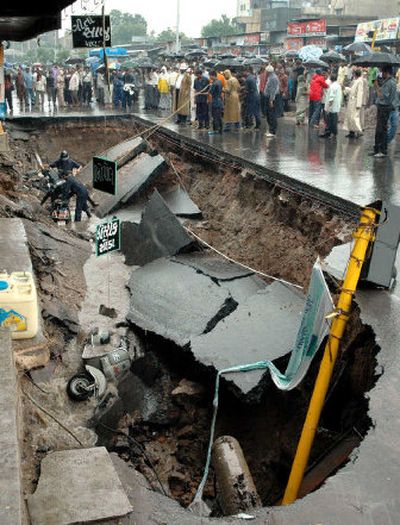Nearly 700 dead in India

BOMBAY, India – Rescuers working beneath leaden skies pulled bodies from rivers of mud and piles of water-soaked debris today as they searched for survivors of record-breaking monsoon rains that killed almost 700 people.
A stampede set off by rumors of a dam burst late Thursday also killed at least 15 people, including seven children, and injured more than 25 in a Bombay shantytown, said R.R. Patil, deputy chief minister of Maharashtra state.
People in the Nehru Nagar slum in northern Bombay panicked after hearing the rumors in the wake of landslides set off by two days of rains that began Tuesday and buried alive dozens of Bombay residents and cut off neighboring villages.
“People died due to false rumors,” Patil said. “Fifteen people have been killed, and seven are children.”
He said police vans with loudspeakers had been deployed to stem the panic.
Today, dozens of new bodies were found pushing the death toll to 696, officials said. Rescuers were searching vast areas in the western Maharashtra state battered rain, said N. Nayar, an official at the government’s emergency control room in Bombay.
The crisis began Tuesday, when the cosmopolitan city that is home to India’s financial and movie industries was hit by an unprecedented deluge of up to 37 inches of rain in some areas, the highest recorded one-day total in India’s history. Much of it came over a few evening hours, transforming roads into fierce rivers.
The rains stretched into Wednesday, paralyzing Bombay and devastating wide swaths of surrounding Maharashtra state before they finally ended Thursday, leaving an overcast sky.
A government-ordered holiday kept workers at home Thursday as normally bustling Bombay, also known as Mumbai, struggled to get back on track. The Bombay Stock Exchange did not open, and many banks and other financial institutions remained shut.
Phone service was still spotty, some neighborhoods remained without electricity, and stretches of road were blocked by hundreds of cars abandoned when they stalled in the rain.
By evening, train service was back and the city’s airports, among the busiest in the nation, were again open to flights.
In the northern Bombay suburb of Saki Naka, relief workers and survivors searched the ruins of a shantytown crushed when a water-soaked hill collapsed on top of it. While the complete toll was unclear, at least 110 people were killed, and more than 45 others were missing and presumed dead.
“It was terrible to pull out little babies from under boulders and mud,” said firefighter S. Shinde, wiping his brow with mud-caked hands. “The very young and the old just didn’t make it.”
Rescuers piled bodies onto trucks and flagged down private cars to carry dozens of injured people to hospitals.
In Bombay, most victims drowned, were crushed by falling walls, or were electrocuted.